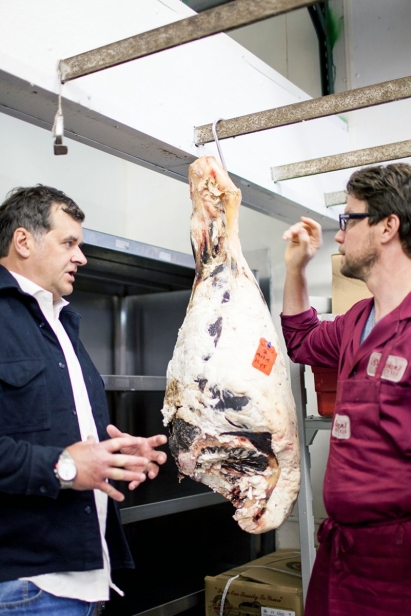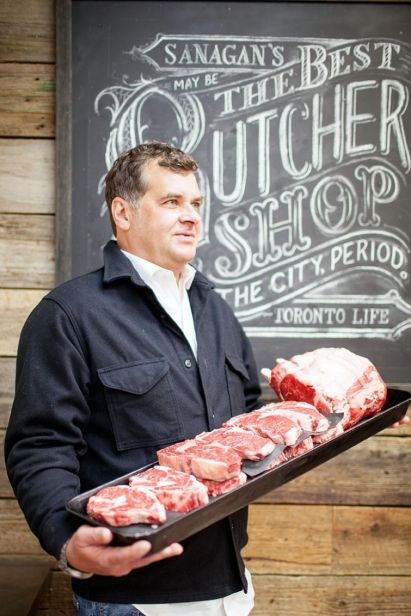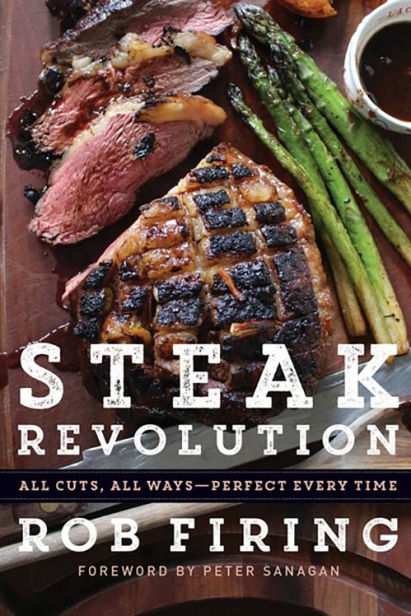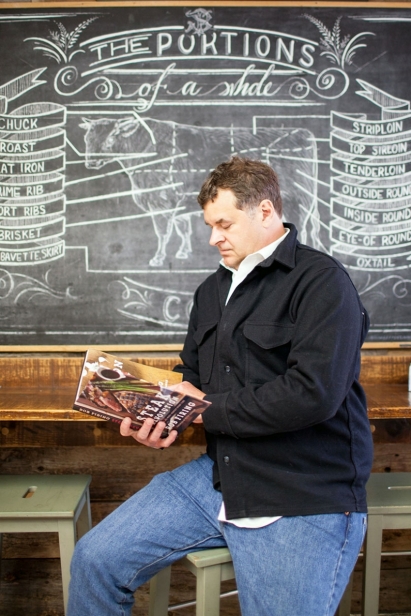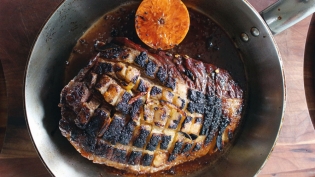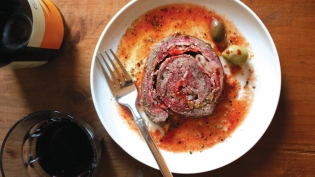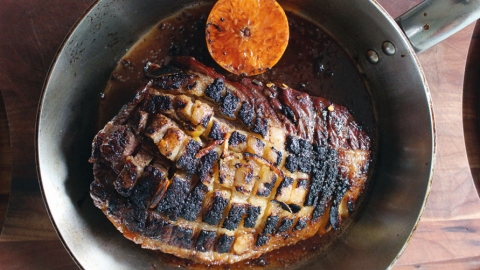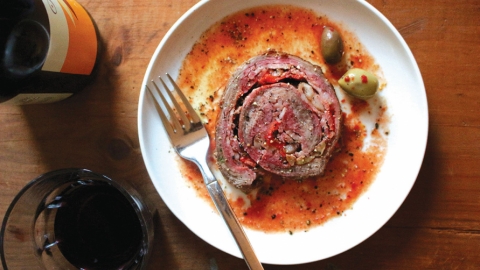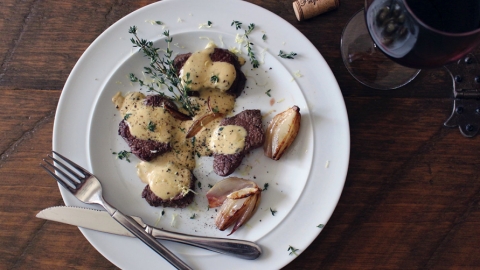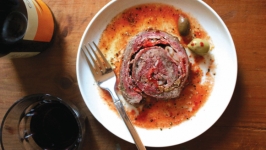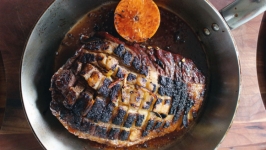Firing Up the Grill
For self-proclaimed steak fanatic Rob Firing, the “aha” moment came while staring at an aged prime rib in a butcher’s case at Rowe Farms in west Toronto. He knew he wanted to write a cookbook about steak.
His long-standing obsession with steak started at a young age — Firing worked at a St. Lawrence Market butcher shop as a teenager and later at The Keg in the city’s Yonge-Eglinton neighbourhood. More recently, he was the Director of Publicity and Communications at HarperCollins Canada, where he worked with chefs and cookbook authors, such as Jamie Oliver, Anthony Bourdain and Derek Dammann. He is also the coauthor of The Everyday Squash Cookbook: The Most Versatile and Affordable Superfood.
Published this spring, his latest cookbook, Steak Revolution: All Cuts, All Ways — Perfect Every Time, is truly a manifesto for everything bovine. Part history of the cow, part recipe collection, the book features expert tips and tricks on butchering, trimming and grilling basics to show readers — whether kitchen novices or veterans — how to cook a steak perfectly.
His premise? Steak doesn’t have to be expensive to be good. Firing emphasizes that each cut is different and can benefit from specific cooking methods. The one thing all cuts of steak need is careful attention — watching them cook is as much a part of the experience as eating them.
The book’s stand-out recipes include pan-fried skirt steak with capers, blistered cherry tomatoes and smash-fried potatoes, rib steak with brown-butter parsnip mash and caramelized leeks and culotte with figgy-marmite and juniper glaze.
For Firing, the true pleasure of steak comes down to the senses. In the cookbook’s introduction, he writes, “a properly cooked steak is immensely satisfying, capturing your attention completely. The tongue tastes, the mouth feels and remembers. Teeth carve and bite and the aromas of dozens of compounds intermingle and delight. Even the sound of steak on the grill is something to stop and listen to, as dinner guests pause their conversations and the crackle and sizzle, watching the smoke and waiting for its scent.”
And yet, despite his life-long enthusiasm for steak, Firing always considered himself a bit of an amateur on the subject and thought he would need a chef to co-write a cookbook such as Steak Revolution. But he contends, a little self-trust is important. “You know more than you think when it comes to something you love.”
Q&A with Rob Firing
What inspired Steak Revolution?
RF: This book came together from so many different approaches, from travelling and trying different restaurants, to experimenting at home and talking to chefs and butchers (especially butchers — Toronto's Peter Sanagan, in particular). Steak Revolution is really a collection of all those memorable experiences and stories. Additionally, I wanted to set the record straight on a few things that I had discovered over the years regarding cows — truly remarkable animals — and some old steak myths.
What advice would you give to a novice cook about buying and preparing steak?
RF: Going to butcher shops, being curious and asking questions and getting to know the variety of cuts is the best way to start educating yourself about steak. As soon as you start to experiment with different cuts of steak, a whole new world opens up. As I say in the book, striploin and tenderloin are terrific, but the cow is a very big beast, so why not try the rest of it?
What kind of recipe would you recommend they start with?
RF: Since we are into outdoor grilling season, a grilled flank steak with a dry chili rub is a great recipe for a beginner. There is one in the book that incorporates dried, preserved lemon into the rub, but you could just as well use storebought chili mix. I sometimes say to myself that if I ever had to cook a hundred steaks for someone's wedding, it would be flank. It's a no-nonsense sort of steak and performs really well at medium rare. The rub allows you to have a nice flavourful, dark crust and not overcook the inside. It’s easy to slice into servings, too, since the grain runs along its length, so cutting it across its width yields tender morsels. At the other end of the spectrum, there is reverse-searing, an awesome and powerful technique that I delve into in the book. Slowly warm a big, thick steak (like a bone-in ribeye) in the oven to about 118F, then sear it quickly on your stovetop, bringing it up another five degrees while achieving an incredibly tasty, dark brown crust. This gives you lots of control and way less smoke indoors. You do need a digital instant-read thermometer for this.
What are your must-have tools for barbecuing?
RF: Besides a good chef's knife, there are two things I recommend as essential tools of the trade. First, an instantread digital thermometer. You can get a compact version about the size of a lollipop or the larger kind, with a wire and a timer, about the size of a tin of sardines. It's really a game changer and will help you get to know when a steak is done by other tests — such as weight and bounce — by knowing the corresponding internal temperature. They retail for anywhere from $35 to $60, depending on the brand and type. The second essential tool I recommend is a pair of heavyduty, stainless steel, scalloped kitchen tongs. These are the sort that are used in everywhere from diners to high-end kitchens around the world. They are spring loaded and can take a decent amount of weight and abuse. When I worked in restaurants, I used to lift loaded hot cast-iron pans with them — not that I'm recommending that. Be careful to get heavy-duty and not salad tongs, which look nearly identical, but are much flimsier. And avoid silicon coated grips or padded ends. The silicone grips are rarely useful and the silicone pads make the tongs totally useless for grilling because your food will slip out of your grasp. Good tongs bring you a remarkable level of control when you need to move the food around on a hot grill or pan.
Describe your perfect steak meal.
RF: If I'm indoors, a glass of Bordeaux and some jazz go pretty darn well with a pan-fried striploin and caramelized onions. But for me, eating outdoors under the stars or the setting sun is the most remarkable experience. In particular, if I'm at the cottage, I like to cook a ridiculously large steak right over a live fire with embers, slow burning wood and just the right amount of smoke. Steak cooked this way is like nothing else. It's as close to Argentine asado-style barbecue as I can get and since the cottage neighbours are far enough away, I can have a nice smoky fire that would probably land me in trouble with the authorities, not to mention my neighbours, if I did this in the city.
When you go out to eat steak, which Toronto restaurants are some of your favourites?
RF: I did have a pretty fantastic dry-aged ribeye at Enoteca Social on College Street not long ago. They totally know what they are doing. A week later, I was still thinking about it. And I have a plan to hit Tanto on Ossington very soon. I hear they are legendary for steaks — I will have to report back and let you know how that goes.
What are you working on next?
RF: The book I'm working now is called Bos Taurus: How the Cow Changed the Course of Civilization. Bos Taurus is the species of cattle we all know in Europe and the Americas (as opposed to its close cousin, Bos Indicus, which roams the streets in parts of India, mostly unharassed). It's not a cookbook, but talks about our history with the cow and how it shaped the trajectory of our societies. What can I say? While researching steak, I fell for cows.
Steak Revolution by Rob Firing ©2018. Published by HarperCollins Publishers Ltd. All rights reserved.



